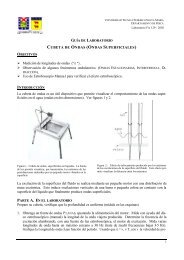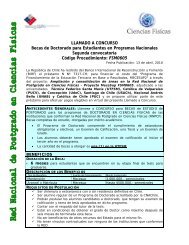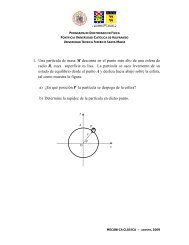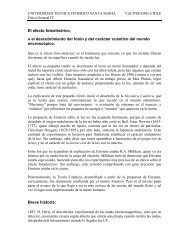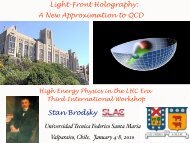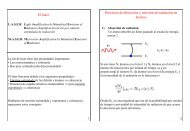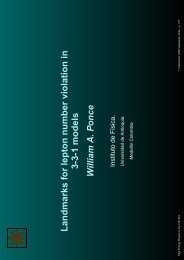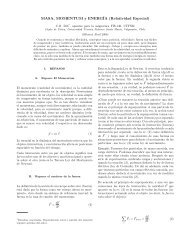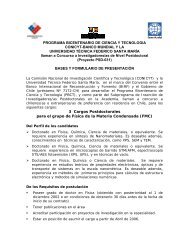Aca - Departamento de Física - Universidad Técnica Federico Santa ...
Aca - Departamento de Física - Universidad Técnica Federico Santa ...
Aca - Departamento de Física - Universidad Técnica Federico Santa ...
You also want an ePaper? Increase the reach of your titles
YUMPU automatically turns print PDFs into web optimized ePapers that Google loves.
V Encuentro Sud Americano <strong>de</strong> Colisiones Inelásticas en la Materia<br />
Atomistic simulations of swift ion bombardment<br />
Eduardo M. Bringa 1<br />
1 CONICET & Instituto <strong>de</strong> Ciencias Básicas, <strong>Universidad</strong> Nacional <strong>de</strong> Cuyo, Mendoza 5500, Argentina<br />
email address corresponding author: ebringa@yahoo.com<br />
Atomistic simulations are often used<br />
to study the bombardment of ions in the regime<br />
where elastic collisions dominate, but<br />
they rarely mo<strong>de</strong>l bombardment when electronic<br />
effects dominate energy <strong>de</strong>position in<br />
the target. There are several mo<strong>de</strong>ls to inclu<strong>de</strong><br />
these electronic effects within classic<br />
molecular dynamics (MD) simulations like<br />
Coulomb explosions, “thermal spikes”, and<br />
etcetera. MD simulations follow the evolution<br />
of a system of atoms interacting trough<br />
some empirical potential. Using current parallel<br />
computers millions of atoms can be<br />
followed during tens of picoseconds. Such<br />
systems are large enough and can be studied<br />
long enough to account for the early stages<br />
of radiation damage. Later stages have to be<br />
studied with other techniques, like kinetic<br />
Monte Carlo or rate theory.<br />
Ion tracks [1], surface craters [2] or<br />
hillocks, electronic sputtering [3], and other<br />
radiation damage indicators can be predicted<br />
in this way. Examples from materials<br />
science, surface physics, and astrophysics<br />
will be shown to illustrate that these mo<strong>de</strong>ls<br />
are relatively simple, but provi<strong>de</strong> a reasonable<br />
<strong>de</strong>scription of experimental results when<br />
electronic stopping power cannot be neglected.<br />
Future directions to <strong>de</strong>scribe electronic<br />
effects in atomistic simulations will<br />
also be discussed.<br />
This work has been carried out in<br />
collaboration with several people, including<br />
D. Schwen, D. Farkas, J. Monk, A.<br />
Caro, J. Rodriguez-Nieva, T. Cassidy,<br />
R.E. Johnson, R. Papaléo, M. Da Silva, C.<br />
Ruestes, and Nestor Arista.<br />
Figure 1. MD simulation of hillocks in tetrahedral<br />
amorphous carbon, showing increasing hillock<br />
height with increasing electronic stopping [4].<br />
References<br />
[1] R. Devanathana, P. Durhamb, J. Dua, L.R.<br />
Corrales and E.M. Bringa, Nuclear Instruments<br />
and Methods in Physics Research Section B 255,<br />
172 (2007).<br />
[2] E.M. Bringa, R.E. Johnson, R. M. Papaléo,<br />
Phys. Rev. B 65, 094113 (2002).<br />
[3] E.M. Bringa and R.E. Johnson, Phys. Rev.<br />
Lett. 88, 165501 (2002).<br />
[4] D. Schwen and E.M. Bringa, submitted<br />
(2010).<br />
18 Valparaíso, Chile



